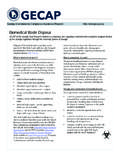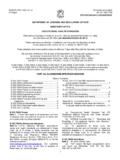Transcription of Management of solid health-care waste at primary …
1 Management of solid health - care waste at primary health - care Centres A decision - making guide Immunization, Vaccines and Biologicals (IVB) Protection of the Human Environment Water, Sanitation and health (WSH) World health Organization Geneva, 2005 iiWHO Library Cataloguing-in-Publication Data Management of solid health - care waste at primary health - care centres : a decision - making guide . waste - standards 2. Medical waste disposal - methods 3. Medical waste disposal - economics health centers - organization and administration making countries health Organization.
2 ISBN 92 4 159274 5 (NLM classification: WA 790) World health Organization 2005 All rights reserved. Publications of the World health Organization can be obtained from Marketing and Dissemination, World health Organization, 20 Avenue Appia, 1211 Geneva 27, Switzerland (tel: +41 22 791 2476; fax: +41 22 791 4857; email: Requests for permission to reproduce or translate WHO publications whether for sale or for noncommercial distribution should be addressed to Marketing and Dissemination, at the above address (fax: +41 22 791 4806.))
3 Email: The designations employed and the presentation of the material in this publication do not imply the expression of any opinion whatsoever on the part of the World health Organization concerning the legal status of any country, territory, city or area or of its authorities, or concerning the delimitation of its frontiers or boundaries. Dotted lines on maps represent approximate border lines for which there may not yet be full agreement. The mention of specific companies or of certain manufacturers products does not imply that they are endorsed or recommended by the World health Organization in preference to others of a similar nature that are not mentioned.
4 Errors and omissions excepted, the names of proprietary products are distinguished by initial capital letters. All reasonable precautions have been taken by WHO to verify the information contained in this publication. However, the published material is being distributed without warranty of any kind, either express or implied. The responsibility for the interpretation and use of the material lies with the reader. In no event shall the World health Organization be liable for damages arising from its use. Printed by the WHO Document Production Services, Geneva, Switzerland iiiTABLE OF CONTENTS 1.
5 Audience ..1 Definition of health - care waste ..2 Scenarii used in this guide ..2 2. BASIC RISKS ASSOCIATED WITH THE POOR Management OF health - care Infectious sharps and occupational Risk to the general public ..3 Risks for the 3. RELATIVE RISK 4. IMPORTANT ISSUES FOR THE SAFE Management OF health - care 5. KEY PARAMETERS TO ASSESS BEFORE SELECTING 6. SCENARII Urban area with access to legally approved modern waste treatment facility ..9 Urban area without access to legally approved modern waste treatment facility ..10 Peri-urban Rural area with access to legally approved modern waste treatment or within reasonable distance.
6 10 Remote area without access to legally approved modern waste treatment or disposal Immunization activities at PHC ..11 Outreach immunization activities ..11 7. 8. EXPLANATION OF CRITERIA AND PRACTICES USED IN THE decision Safe transportation Disinfection with bleach ..11 Encapsulation of needles ..12 Municipal waste stream ..12 Space available on premises ..12 Densely populated area ..12 Acceptable operating conditions for incineration of non plastic 9. COSTING 10. health care waste Management 11. INTRODUCTION TO TREATMENT iv TABLE 1.
7 Approximate percentage of waste type per total waste in PHC TABLE 2. Basic elements of the safe Management of HCW for PHC ANNEX A. Further sources of information on the Management of health - care ANNEX B. waste prevention, reduction and ANNEX C. waste treatment technologies ..40 ANNEX D. Local solutions for managing health - care ANNEX E. Land disposal ..44 ANNEX F. Management of specific wastes ..47 ANNEX G. Case study: Estimating the costs of recycling the plastic of AD LIST OF FIGURES 1. Urban area with access to legally approved modern waste treatment facility.
8 29 2. Urban area without access to legally approved modern waste treatment facility ..30 3. Peri-urban area ..31 4. Rural area without access to legally approved modern waste treatment or disposal facility .. 32 5. Needle-syringes waste Management - Immunization at PHC .. 33 6. Needle-syringes waste Management - outreach immunization activities ..34 ABBREVIATIONS HCW health - care waste HCWM health - care waste Management PHC primary health care centres 11. Introduction The objective of this document is to provide guidance for selecting the most appropriate for option safely managing solid waste generated at primary health - care centres (PHCs) in developing countries.
9 The main tool of this guide consists of six decision -trees aimed at assisting the user in identifying appropriate waste Management methods. The guide takes into consideration the most relevant local conditions, the safety of workers and of the general public as well as of environmental criteria. This guide is composed of the following parts: i. Basic risks associated with poor Management of heath care waste . ii. Basic elements for safe health - care waste Management (HCWM) iii. Parameters to assess before selecting HCWM options iv. Technical annexes describing HCWM options v.
10 Estimation of costs of the various options vi. decision -trees, assisting the selection of HCWM options This guide may also be used to evaluate existing practices related to health - care waste Management . More detailed sources of information on handling and storage practices, technical options for treatment and disposal of wastes, training and personal protection, and assessment of a country s situation, are presented in Annex A. Audience The audience for the guide includes the staff working in primary health - care centres and the technical staff working in the local, state or central administration.
















